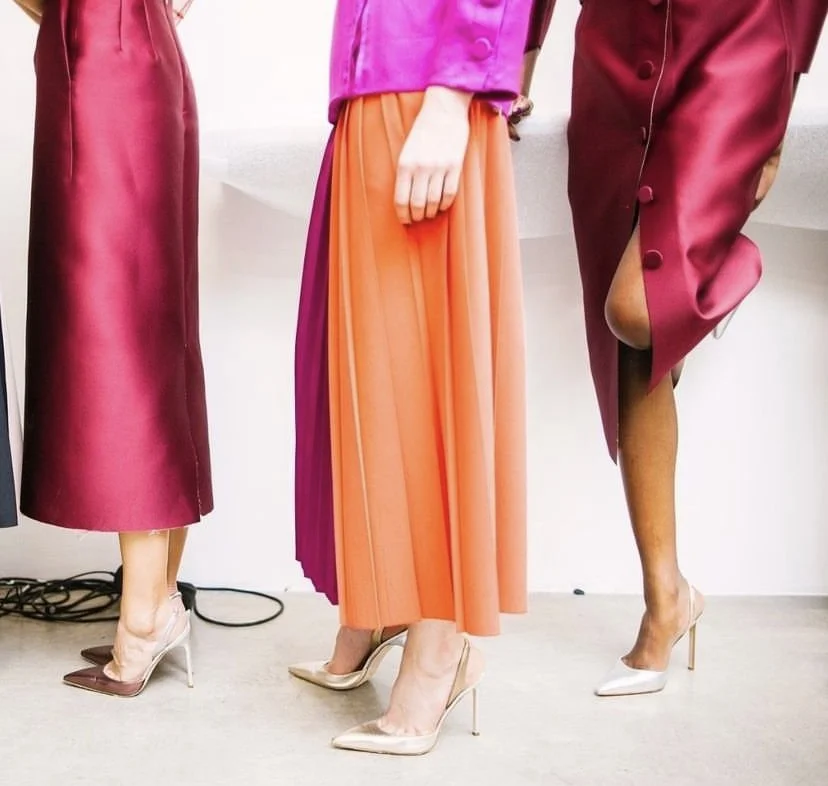How To Pitch Like A Pro
Pitching. It’s enough to make many people quake in their boots!
I know just how daunting it can be: Proving to a complete stranger (or worse, a group of strangers…) why you’re worth their time and consideration.
However, it doesn’t have to be as worrisome as you may think.
Having worked in buying for 15 years, I was head of beauty buying at the one and only Selfridges for a long time. This means I’ve received thousands of pitches - even some of the biggest brands out there have to pitch to get stocked by a retailer. Charlotte Tilbury herself gave hers to me! On top of this, I’ve judged awards, most recently the Retail Systems Awards where I reviewed multiple pitches and helped numerous businesses build their B2B relationships through their pitch deck and process.
This experience means that I know what makes a pitch stand out, whether it’s pitching a new brand, building existing partnerships or putting your business forward for an award. Knowing how to pitch will be beneficial in countless business and life settings, so you should definitely make the most of these tips, even if you’re not at that stage yet.
How can you stand out and make sure that you’re pitch perfect? Let’s get into the six simple steps.
Refine your USP
Don’t switch off! I know you’ve heard this one before.
However, it’s for a good reason. Having a clear, concise and really perfected USP is a key to so many business successes.
Trust me, without explaining clearly and succinctly your point of difference, you won’t stand out among the sea of pitches that is being reviewed.
To get clear on your Unique Selling Point, I suggest focusing on four key areas…
An Elevator Pitch (or Mission Statement): One line that describes your brand and by far the most important part of communicating your point of difference.
A Brand Message: A couple of sentences that describe what the brand does. Be as concise and specific as possible.
Your Brand values: Five (ish) words that are the core beliefs of your brand. Think of these as the brand’s personality!
Your Brand Story: The longer “why” of your brand. I recommend creating this in a variety of lengths (for example, 100, 250 and 500 words). You’ll find them useful for countless scenarios.
Within these four areas, hone in on what makes you different from others on the market. Your ingredients, ethical values, brand story, ethics, packaging, business model or something else? Then ask yourself: Is there some way I could further refine this?
And remember: New brands pop up all the time, so you should keep reviewing this. When Drunk Elephant launched they really stood out in the market. However, clean beauty is no longer enough of a selling point. Avoid buzzwords like sustainable, natural, ethical and clean. These may be important, but they’re not a big enough point of difference anymore.
Want to learn more? We have a whole guide to finding your USP in this blog post.
2. Do your research
There’s no denying that every retailer is different.
I mean, are ASOS and Harrods targeting the same audience? Hardly!
And whilst having a USP is a great starting point, it isn’t enough. You need to appeal directly to the retailer that you’re talking to, which will help to validate your proposal. Do this by getting familiar with them as a brand through research. This can range in everything from reading trade press, to simply assessing their website and socials to see what information you can gather.
Think particularly about the following…
What brands have they launched recently? Are there too many that are extremely similar to you? Or brands that align with your one but leave space for a product like yours?
Do you share a target audience with the retailer? Figure this out by seeing what age range they post on their socials, what their tone of voice is and who this attracts, plus through any stats they make available about their audience.
Does their projection of sales align with your goals?
How does the retailer appear to help other brands with marketing? Are they doing what you would need them to?
3. Tailor your pitch to the retailer
So. You know you’re a good fit for a retailer. Now it’s time to show them that this is the case!
The truth is, the reader will be able to tell from a mile off whether a pitch has been personalised to them. Research and preparation are therefore absolutely essential - At a bare minimum, you need to make sure you’re clear on who you want to contact, have a decent amount of information about them and their role, and are clear on why you’re a perfect fit for them.
Don’t copy and paste every pitch you make, but instead focus on how you can adapt it perfectly for the audience. Gather information about their targets and how you can help them to reach that. Explain how your values align. Explore what category you would fall into and therefore where you’d sit on their shelves. There are countless ways that you can show you’re a fabulous fit, so get brainstorming!
4. Focus on trending categories
What’s trending?
This is a powerful question when it comes to positioning your brand to perfection. If you can bring together a popular theme and your own formula for long-term success, BOOM, you’re onto a winning thing in terms of validating your proposal!
Whilst longevity is of course more important, utilising a trending category can make a retailer’s ears prick up when they hear about you. So, make sure that you stay up-to-date with what’s happening through industry news. I regularly share insights to my mailing list - Be sure to sign up here.
Sustainability, a new definition of luxury and transparency are some consumer trends that are a huge movement. To learn more about them and how your brand can harness them, check out this blog post we wrote once you’re finished with this one.
Don’t forget to follow us on IG or LinkedIn for on-the-pulse news and thoughts.
5. Prove your sales value
This is essentially your brag list! It’s an explanation of why you’re so bloody brilliant and why a retailer should trust you as a brand that they stock.
Simply think about what you’re most proud of in your business:
Have you had brilliant growth in sales?
Have you been featured in the press?
Has another retailer had great success with you?
Is your marketing extremely effective?
Basically, this is your chance to really sell it with your stats! Demonstrate your “proof of concepts” in your pitch, something which is too often overlooked, and you’re much more likely to hook a buyer in. There are often many KPI’s you can include in your deck and something I work with brands on to ensure they are really highlighting the commercial potential to the buyer.
This is about getting your brand seen and heard in multiple different places, a core strategy for brand building. It can feel overwhelming, but creating a strategy to implement this is crucial to getting recognition from buyers and customers. Check out my free masterclass on the ingredients for creating a disruptive brand that builds hype and recognition in the market!
Without some key commercial milestones, the reader is unlikely to take notice, honestly, this is forgotten a lot, even when there has been a clear brief such as applying for an award.
6. Get ready to negotiate
Unfortunately, it’s rarely as simple as pitching, shaking hands and seeing your products on the shelves. In fact, it never is!
Prepare yourself for negotiations related to all things practical, as retailers try to get the best deal possible for themselves. Make sure you’re clear on what your financial expectations are and what kind of trading terms you want to best protect your cash flow.
These can often be confusing, which is why it’s a topic I cover in my programme about pitching to retailers. Plus, these pitch documents can be used in countless situations.
The key things to consider are…
Commission splits: Who gets what after each sale?
Payment terms post delivery and invoice: Is this something you can manage? It’s the industry norm in terms of retailers paying for products.
Consignment: Are you happy for your retailer to pay you back after they’ve sold the product or would you need them to do so beforehand?
There are many variables to be aware of so going into the pitch prepared will give you more confidence.
Hopefully, these six tips have set you up for success and on the path to pitch confidence. However, if you’re still feeling a bit shaky at the knees about pitching, don’t fret.
When you are ready to pitch, I’m here to help! Whether you need 1:1 advice on refining your USP or want to learn step-by-step exactly what to do to get your pitch ready and have it reviewed by me, I have different ways you can access support and information.
If you would like to work with me 1:1 to supercharge your strategy and get tailored advice on your positioning, pitch and strategy then book a discovery call.
CLIENT WINS
"I knew we had a great product but as a scaling startup, we didn't have the network or time to grow at the speed we needed. Wizz was able to help guide decisions which ultimately helped us grow our presence. Working with Wizz means she quickly becomes a trusted advisor to you and your team. It means:
A guaranteed clarity of consumer needs - what they care about and what they don't
It's a finger on the pulse with trends
It's a deep understanding of the challenges the market is facing
It's about getting the product market fit in the least amount of time
For those new to the industry, you're in safe hands - Wizz is able to clearly explain the industry nuances while keeping a strong commercial focus behind every conversation."
- Charlotte, Beauty Tech Co-founder
Before we worked with Wizz we had not secured any retail contacts. We worked together over a number of months, she helped shape our brand story and supported our vision and strategy to grow the business. Within four months of working with Wizz, we have secured our dream retail partner. Without her support, advice and direction I do not think this would have been possible. Wizz has been amazing for our business.
Stocked with Cult Beauty and Credo - Fiona, founder of Nessa Organics
"Buyers often comment on how good the pitch deck is. It’s now my bible to use for meetings, not just with buyers but the press, partnerships and whoever I need to communicate the brands USP and growth opportunities"
Stocked with Harrods and Galerie Lafayette - Lune, founder of Monday Muse



